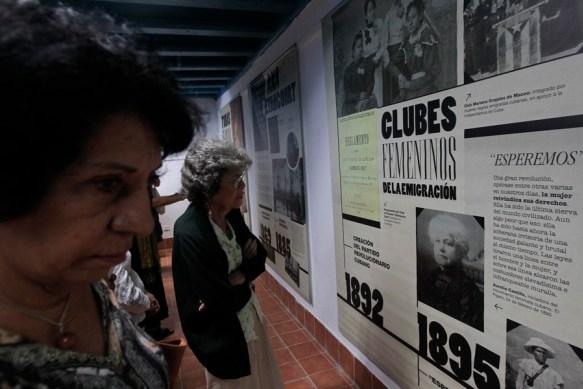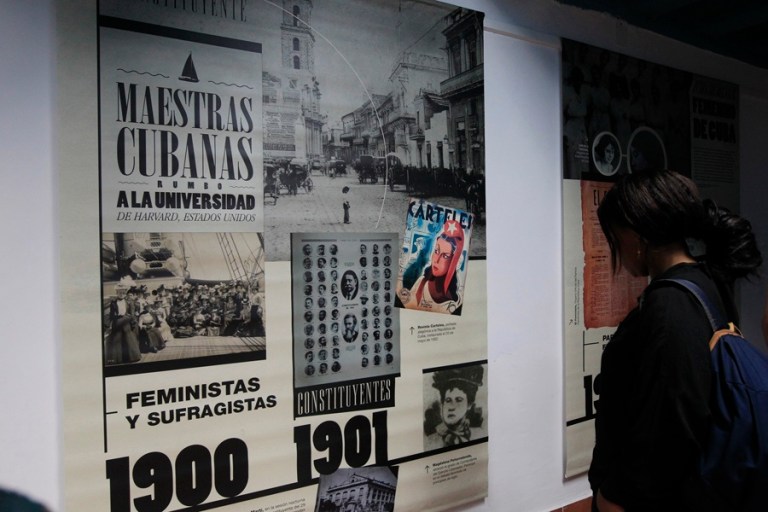Feminism Exhibit Now in Havana to also Tour Cuban Provinces
“En busca de un espacio” (In search of a space) is open to the public in Havana’s Palacio del Segundo Cabo until March 3rd, and will then go on a tour to other Cuban provinces.

HAVANA TIMES – Telling the history of Cuban women, who have almost always been pretty much invisible or overshadowed by the great feats accomplished by men, is the debt that the TODAS: En busca de un espacio (In search of a space) exhibit is trying to settle.
On display at the Cuba-Europe Cultural Relations Center in the Palacio del Segundo Cabo, the exhibit is made up of 14 panels which reflect moments from the Cuban women’s rights struggles between 1860 and 1940, with a special emphasis on the three National Women’s Congresses (1923, 1925 y 1939) and groundbreaking legislation.
Some of the milestones chosen for the exhibition (which is open to the public until March 3rd), feature the founding of the National Feminist Party (1912), the Cuban Women’s Club (1918) and the National Federation of Women’s Associations (1921), as well as the passing of the Parental Rights Law (1917), the Divorce Law (1918) and the right to vote (1934).

Proposal
“We are proposing a timeline, which can open up and include other events and women who we discover as we travel through different parts of the country with the traveling exhibition,” said filmmaker Marilyn Solaya, the project coordinator, during the exhibition’s inauguration on January 30th.
The director of the TODAS project and the documentary En busca de un espacio (2019), (the fusion of which has now become the name of the exhibit), explains that “this is the beginning of a project that will include exhibits, documentaries, movies, training, community workshops, education for children, as well as other initiatives.”
In her eyes, while “a lot is being said in this country today about rescuing our history, there is still a debt to give the contributions women have made in different areas back to society.”
According to the director of award-winning movie Vestido de Novia (2014), “the great history of Cuban women still needs to be told from an academic standpoint, and from film even more so.”
She added that the project “is an incentive so that every museum, cultural center and the National Union of Writers and Artists of Cuba (UNEAC) office in the provinces, has a special space dedicated to exemplary women from those places.”
She also said that just as much as “there is a great abyss in awareness and knowledge”, there is “a desire to delve into this other facet of History.”
“After talking about the project on national TV, I’ve been sent, in every way possible, the names of some 500 exemplary women from different places in the country and from different professions, in just a week!” noted Solaya.
She believes that “these and the women who are still missing, which I’m sure figure in the thousands, will inspire a great database.”
Solaya will be joined during this entire process, from the exhibit’s conception to every exhibit on the road, by historian Julio Cesar Gonzalez Pages, the curatorship of Neida Penalver and designs by renowned artist Miguel Monkc.

Inclusive Exhibit
One of the subjects that the exhibit addresses is the mark that Spanish immigrants left on Cuba’s feminist debate, “an idea that has the intention of exposing part of the legacy these women left behind, who also formed part of our society and took part in the nation-building process,” the actress and scriptwriter also pointed out.
Later on, she stresses that “the project will recover the legacy of Chinese, Polish and Jewish women, delve deeper into the contributions made by black women and others who form part of the great cultural melting pot we are as a country.”
Furthermore, TODAS: En busca de un espacio included a print dedicated to “male allies”, which refers to the intellectuals who joined the voices to these women’s demands for their rights in Cuba, in the early decades of the 19th century.
Pro-feminist Cuban men that appear in the print include anthropologist Fernando Ortiz, historian Emilio Roig, student movement leader Julio Antonio Mella, writer and journalist Carlos Loveira and lawyer and revolutionary Juan Marinello.
“They also contributed to the struggle for our rights, and it’s an appeal for us to seek alliances with men that are sensitive to our cause,” she pointed out.

Feminism today
Experts and artists who have formed part of the project, exhibit and the documentary believe that they allow for us to connect past and present efforts in the fight for equal rights, opportunities and possibilities for women in Cuba.
Writer and anthropologist Julio Cesar Gonzalez Pages said that these two works “allow for us to contextualize feminism and the Cuban women’s movement and to also show the contributions Cuban women have made to society in all of their glory, reclaiming rights that today’s generations have inherited and should defend.”
According to the academic, “these women that appear in the documentary and the exhibition were the pioneers, the women who started up the struggle for women’s civil and political rights in the country, at the time when it was really hard to challenge the status quo, which is reason enough to pay tribute to their lives.”
Meanwhile, the author of the book of the same name which served as inspiration and gives its name to the documentary, stressed that one of TODAS’ most important messages “is unity”.
He believes that “while there were many different women, they all wanted to reclaim political citizenship, and they had to close ranks for a common cause.”
Gonzalez said that “this message of unity is relevant today, because there are many initiatives working on similar issues, but they aren’t bridging gaps, and that leaves space for those with arguments against women’s rights.”
Amada Morado, one of the actresses involved in the documentary and who will also feature in Solaya’s next full-length movie, pointed out that “we should continue a dialogue with the work of such important women, but from the present.”
Morado, who plays the character Maria Luisa Dolz, the first Cuban woman to graduate in Pedagogical Sciences, is grateful for the opportunity to “discover such a special woman, who dedicated her life to opening up doors for women through education.”
Meanwhile, Rodrigo Garcia Ameneiro, pianist and responsible for the movie’s soundtrack, said that the project “is interesting from its very title, a kind of philosophy that applies to many aspects of life, because we are always looking for a space to occupy as human beings, as artists and to pave our own authentic path.”
Another value of the documentary was highlighted: its capacity to summarize and its possible contributions outside of the film world.
Academic researcher Norma Vasallo, one of the interviewees that appears in the documentary, said that ever since the documentary made its debut, it is now shown and replaces a conference about the same subject in her classes at the University of Havana.
This was exactly one of Marilyn Solaya’s incentives, who said that “between the research process and future movie is the TODAS project with workshops, congresses, panels, tours, training and other multiple spaces to grow and contribute to society.”
The filmmaker underlined that the “beyond documentaries and their artistic value”, she aspires to “create works that can be shown in schools, debated in communities, in the media, movies that circulate outside of the red carpet.”
—–
The TODAS Project
The TODAS Project, coordinated by filmmaker Marilyn Solaya, seeks to give historic recognition to the Cuban women who fought for rights that women today enjoy, advances made by present generations and gender equality efforts.
The director explained that the initiative also seeks to “shine a light on the contribution Cuban women made to building the nation, with a historic focus, linking to the future and encouraging young women and girls to become empowered and to find female role models.”
Solaya insisted that TODAS is a “unifying” project, that joins the efforts and determination of many people, institutions and organizations.
She mentioned the vital alliance with the Ibero-American and African Masculinities Network, the Cuban Institute of Cinematographic Art and Industry, Palacio del Segundo Cabo, the Women Teachers at Universidad de La Habana, the National Lawyer’s Association and the Havana Historian’s Office.
She also has support from the Basque NGO Desarrollo Kultura Communication y Desarrollo, Bilbao Spain’s Invisible Film Festival, the Cultural Office at the Spanish Embassy in Havana and the Swiss Agency for Development and Cooperation.






One only has to walk down any busy street in Cuba today and watch women standing in line for hours under the hot sun to buy basic necessities for their families.
Rarely does one see a male, even if they have a day off from work, standing for so long to buy consumer goods. – basic necessities such as bread and soap.
I don’t think this situation has anything to do with feminism but the historical fact that women, particularly in Latin American countries such as Cuba, are the matriarchs and they take the responsibility for family well being extremely seriously.
Absolutely, Cuban women need to be recognized for their other historical exploits which the article clearly states, but they are not “…almost always been pretty much invisible…” when their valuable contribution to their families and society are so demonstrably evident, and clearly visible on a daily basis.